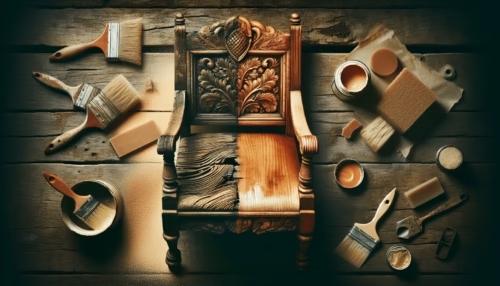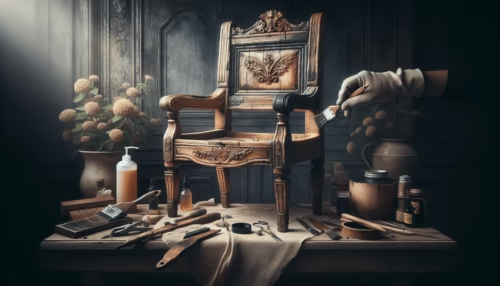What makes a piece of furniture truly antique, and how can one preserve and restore its timeless beauty while maintaining its historical significance? This guide aims to equip enthusiasts, craftsmen, and collectors with essential knowledge about antique furniture restoration and care. The discipline demands a blend of artistry, historical knowledge, and practical expertise, which can both fascinate and daunt those who embark on this journey.

Table of Contents
Understanding the Significance of Antique Furniture
Antique furniture serves as a window into the past, offering insights into the design, craftsmanship, and lifestyle of bygone eras. Defined as pieces that are at least 100 years old, they carry with them stories of previous owners and the hands that crafted them. Each mark and blemish on a piece narrates a story, inviting us to delve deeper into its history. Restoring such pieces requires a delicate balance—preserving its originality while enhancing its utility and aesthetic appeal.
Historical Context
Antique furniture has its roots scattered across various historical periods, each with its distinct styles and characteristics. From the ornate Baroque and Rococo designs to the clean and elegant lines of Georgian and Victorian eras, understanding these styles is imperative for accurate restoration. The techniques used in crafting these pieces often reflect the socio-economic conditions of their time. For instance, during the Industrial Revolution, machinery enabled mass production, leading to simpler designs compared to hand-carved pieces of the earlier periods.
Recognizing Styles and Periods
Recognizing the distinct styles and periods of antique furniture is the cornerstone of effective restoration. Each period, such as Queen Anne, Chippendale, and Louis XVI, exhibits unique characteristics in material use, ornamentation, and design philosophy. A restorer must be versed in these details to ensure that their interventions do not disrupt the historical authenticity of the piece. Knowledge of significant furniture makers and their signature styles further enhances a restorer’s repertoire.
Essential Tools and Materials for Restoration
Having the right tools and materials is crucial for anyone involved in the restoration of antique furniture. Precision in the selection and application of these tools can significantly impact the quality of the restoration work.
Basic Tool Kit
A basic toolkit for furniture restoration includes items such as chisels, planes, sandpaper, and a quality wood adhesive. Each tool serves a specific purpose, from carving and shaping wood to smoothing surfaces and joining parts. High-quality versions of these tools, crafted to maintain their edge and durability, are recommended for professional results.
Material Selection
Choosing the right materials is as important as choosing the right tools. This includes selecting the appropriate type of wood, veneer, finishes, and adhesives. Originality is key, so whenever possible, matching the materials from the same period or style of the piece is preferred. Equally important is ensuring that these materials are compatible with the original structure to avoid further deterioration.

Restoration Techniques
Restoration techniques can vary widely depending on the type of furniture and the extent of damage. These techniques often combine traditional methods with modern enhancements to ensure a restored piece retains its functional and aesthetic qualities.
Cleaning and Surface Preparation
The first step in restoration often involves cleaning and preparing the surface. Dust, grime, and old finishes are carefully removed to reveal the original wood’s condition and grain. Using mild detergents and appropriate solvents prevents damage to the surface while ensuring thorough cleaning.
Repairing and Replacing Parts
Once cleaned, the next step involves repairing and replacing damaged parts. This could range from fixing loose joints and broken legs to replacing missing veneer pieces. Precision and discretion are essential here, as any repairs should blend seamlessly with the original structure.
Finishing Techniques
The finishing process is pivotal in enhancing the visual appeal and longevity of the furniture. Techniques such as French polishing, oil finishing, or varnishing can be used depending on the period and style of the piece. Each technique provides a different finish, influencing the furniture’s final appearance and feel.
Conservation vs. Restoration
While both processes aim to maintain antique furniture, they adopt different approaches. Restoration focuses on returning the piece to its original condition, often enhancing its functionality and aesthetics. Conservation, however, emphasizes preserving the piece in its current state, intervening only to prevent further deterioration.
Deciding Between Conservation and Restoration
The choice between conservation and restoration depends largely on the piece’s historical value, condition, and intended use. In some cases, over-restoration can diminish a piece’s authenticity, whereas minimal conservation can preserve its original charm.
Ethics and Best Practices
Following ethical guidelines ensures that the integrity and historical significance of antique furniture are maintained. Best practices recommend minimal interference, reversible methods, and detailed documentation of any work undertaken. Such guidelines help future restorers and allow the piece’s history to be accurately passed down through generations.

Case Studies and Comparisons
Looking at real-world examples of successful restoration projects can provide insight and inspiration. For instance, restoring a 19th-century William and Mary highboy demands a different approach compared to a mid-century modern teak chair, reflecting differences in materials, construction, and purpose.
Success Stories
Highlighting successful restoration stories offers a glimpse into the complexities and rewards of this craft. These case studies often illustrate the thoughtful process of research, selection, and application of techniques, honoring the original intent while breathing new life into the furniture.
Comparison of Techniques
A comparison of different restoration methods can reveal their nuanced differences. For example, hand tools may be preferable for delicate veneer work, whereas mechanical tools might be utilized for more extensive structural repairs.
| Technique | Purpose | Materials Used | Advantages |
|---|---|---|---|
| French Polishing | Provides a high-gloss, smooth finish | Shellac, alcohol | Timeless appeal, depth of color |
| Oil Finishing | Enhances natural wood grain | Tung oil, linseed oil | Easy maintenance, natural finish |
| Varnishing | Offers a durable and hard finish | Varnish | Protection against wear and tear |
Problem-Solving Strategies
Challenges are an inherent part of antique furniture restoration. Whether dealing with stubborn stains or pest damage, each problem offers an opportunity to apply innovative solutions and prevent future issues.
Addressing Common Issues
Common issues such as warping, scratches, or woodworm require specific strategies. For instance, sanding can resolve surface scratches, while injecting woodworm treatment directly into affected areas can prevent further damage.
Preventive Measures
Preventive measures help maintain restored furniture’s condition. This includes controlling the environment to prevent humidity and temperature fluctuations, which can adversely affect the wood. Regular cleaning with appropriate products also ensures that dirt and grime do not accumulate on the surface.

Future Trends in Antique Furniture Care
The world of antique furniture restoration is evolving with new trends and methods. Technological advancements are increasingly integrated into traditional practices, offering novel solutions and enhancing restoration capabilities.
Technological Innovations
Modern technology, such as 3D scanning and printing, opens new possibilities for replication of intricate parts without compromising historical accuracy. Similarly, environmental monitoring systems help maintain optimal conditions for furniture preservation.
Sustainability in Restoration
Sustainability is becoming a core consideration in restoration practices. Using eco-friendly materials, recycling old components, and reducing waste contribute to the long-term health of both the furniture and the environment.
Conclusion and Continuous Learning
Antique furniture restoration is a lifelong learning journey that combines respect for heritage with artistic craftsmanship. This guide has only scratched the surface of the knowledge and skills required to master this discipline.
Engaging with the Community
Involvement in restoration communities and networks enables shared learning and development. Workshops, exhibitions, and online forums provide opportunities for continuous education and inspiration.
Resources for Further Exploration
Numerous resources are available for those interested in deepening their understanding of antique furniture care. Recommended readings include “The Furniture Bible” by Christophe Pourny and “Antique Furniture Restoration” by Peter Cook. Additionally, digital platforms and museums offer a wealth of information and insights.
In conclusion, caring for antique furniture is more than just preservation—it is about cherishing history and keeping its stories alive through attentive restoration and ethical practices. This pursuit requires dedication, patience, and a love for the art of history.

Expert advice on caring of antique furniture.
Finding the Right Balance: Collecting and Other Responsibilities

